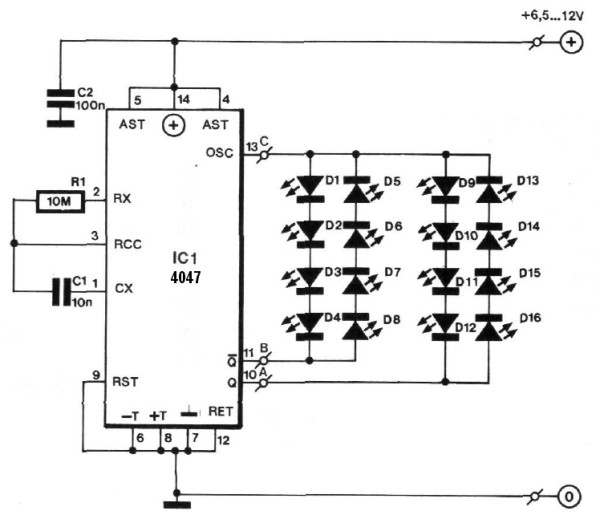Small Circuits Revival (49): Christmas Flasher
on
Christmas Flasher
Idea: Elektor Lab
When Christmas is around the corner, the days are the shortest, the nights are the longest and we need light and a bit of life in the brewery. The latter is of course, quite a bit disappointing this year, but we can do something about the former with little effort.
We can use a Christmas card or a homemade Christmas drawing (or whatever) as a basis for this project, stick it on a piece of plexiglass, and then drill 16 holes of 3 mm in tactical places. We will later install the flashing LEDs in it. We leave the practical artistic implementation entirely to you. Figure 1 is only a suggestion.

As far as electronics are concerned, we have deliberately kept it as simple as possible (see Figure 2). IC1 is a 4047 (one of those "good-old" CMOS ICs) that is used here as an astable multivibrator (in plain English: a square wave oscillator). The flash frequency is determined by R1 and C1 and, depending on component tolerances, will be on the order of one-tenth a hertz or so. The experimenters among you can indulge themselves here!

The LEDs are connected in series per four pieces. Two of these series circuits are in turn connected in an anti-parallel manner and connected from the OSC output to the Q and /Q outputs of the oscillator. Q and /Q are (at a duty cycle of 50%) in opposite phase. If Q is high, /Q is low and vice versa.
The nice thing is that the OSC output of the IC has a square wave with twice the frequency of that on Q and /Q. Let's assume OSC is high, Q is high, and /Q is low. LEDs D9 ... D16 will be off, D1 ... D4 will light up and D5 ... D8 will be off. Half an OSC period later, the state of both Q outputs has not yet changed, but OSC is low. Then D1 ... D8 are extinguished, as well as D9 ... D12; now D13 ... D16 will light up. We leave it to you with peace of mind to check all possible combinations. If the LEDs are mounted a bit "randomly," this results in a very nice blink that at first glance makes an accidental impression (but that is of course not).
As far as construction is concerned, we can be brief: that works fine on a piece of breadboard. Anything that supplies a reasonably stable DC voltage of 6.5 ... 12 V can be used for the power supply. A 9-V "block" is well suited.
We wish you lots of fun crafting and, despite the "viral" circumstances, a merry Christmas and a happy and above all healthy 2021!
Want more? Check out these other small circuits.


Discussion (0 comments)